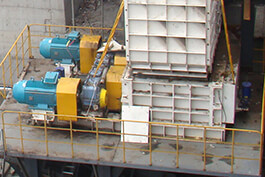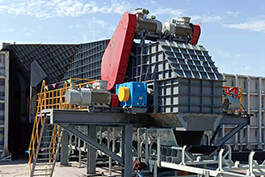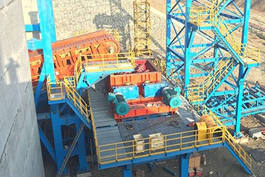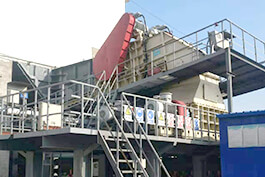Mineral sizer is mainly used for the first crushing/primary crushing, as well as the second and third crushing stages. It can be used for crushing surface rocks, coal, limestone, clay, shale, oil shale, granite, iron ore, gold ore, copper ore, lead-zinc ore, nickel ore, talc, coke and other rock and mineral materials in open-pit mines.
Considerations for tooth profile design
Material properties
Material properties are crucial considerations in tooth profile design, which include the hardness, toughness, temperature and internal stress distribution of the material. The requirements for the tooth profile of mineral sizer vary for materials with different properties. Therefore, it is necessary to select the appropriate tooth profile based on the characteristics of the material to ensure the crushing effect.
For instance, materials with higher hardness may require sharper tooth shapes for cutting and crushing, while materials with greater toughness may need thicker tooth shapes to resist the tensile and shearing forces of the materials. In addition, the temperature of the material and the internal stress distribution can also affect the wear of the tooth profile and the crushing effect. Therefore, when designing the tooth profile of a mineral sizer, these factors need to be fully considered.
Size of the crushing cavity
The size of the crushing cavity is another key factor in the tooth profile design. The design of the tooth profile must adapt to the internal space limitations of the mineral sizer and the movement trajectory of the material as it passes through the crushing chamber. The size and shape of the crushing chamber will affect the flow mode and crushing effect of the material in the crushing chamber.
Therefore, the design of the tooth profile needs to ensure that the material can smoothly contact the tooth roller and be fully crushed. A reasonable tooth profile design can enhance the crushing efficiency of mineral sizer, reduce energy consumption and wear, and thereby extend the service life of mineral sizer.
Material structure and processing capacity
The particle composition of the material and the required processing capacity are also important considerations in the tooth profile design. According to the particle size, shape and distribution of the material, the tooth profile layout of mineral sizer can be adjusted, such as interlocking arrangement, parallel arrangement or other forms, to achieve better biting effect and higher crushing efficiency.
At the same time, the demand for processing capacity will also affect the number and arrangement of tooth profiles. When handling a large amount of materials, it is necessary to design a denser and more efficient tooth profile layout to enhance the production capacity and efficiency of the crusher. By optimizing the tooth profile structure and arrangement, the crushing effect and processing capacity of the mineral sizer are further enhanced.
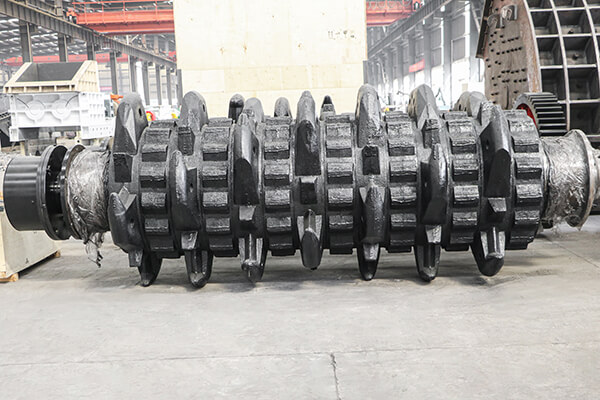
The toothed structure of Mineral sizer
Unlike the squeezing between plates in jaw crushers, Mineral sizer involves the contact between teeth. The working principle of Mineral sizer is based on directly applying shear force to rock materials, generating a huge crushing force along the weak and fragile parts of the materials to break them. To achieve this goal, the tooth shape and size of the gear teeth should be designed as large teeth with special tooth shapes in accordance with the principle of shear force.
The material is discharged between the two teeth and between it and the side wall comb-shaped plate, so the product is controlled by this gap after crushing, with uniform particle size and no excessive particle size. Materials that reach the "qualified" particle size during feeding or crushing will be quickly discharged from the mineral sizer and will not be "overcrushed". Thus, the mineral sizer has excellent screening and particle size control effects.
The machine features a protruding low frame, and the entire mineral sizer structure is very compact and simple. It is very convenient to feed and discharge materials, operate and maintain, and replace vulnerable parts. Mineral sizer can concentrate all loads and pressures within the machine, thus eliminating the need for a bulky chassis, saving space and reducing manufacturing costs.
The working principle and performance characteristics of Mineral sizer
(1) The equipment has a compact structure and small volume
The working principle of Mineral sizer is that crushing teeth are installed on two relatively rotating shafts. The torque on the two shafts is transmitted to the crushing teeth, which exert a force on the material to break it down. The transmission system of Mineral sizer uses gear rotation and hydraulic couplings to eliminate overload loads. Therefore, its frame and transmission parts have a simple structure, low height, light weight, and are convenient for installation, transportation and maintenance.
(2) Smooth operation and low noise
Since the Mineral sizer only crushes materials by the shear force acting on the two toothed rollers, the reaction force acts on the frame to form internal forces. Therefore, in addition to the weight of the equipment itself, the additional dynamic loads on the foundation are only the balanced impact force generated during material crushing and the centrifugal force caused by the pressure imbalance of the low-speed rotating crushing shaft. In fact, these two forces are very small, so the additional dynamic load borne by the foundation supporting the crusher is very small.
The rotational speed of the Mineral sizer is relatively low, and the additional dynamic load on the crushing shaft bearings caused by the dynamic imbalance of the crushing shaft is very low compared with impact and hammer crushers. Therefore, the service life of the bearings and the fatigue life of the shafts have been greatly enhanced. Moreover, due to the relatively low rotational speed of the gear hobbing crusher, its mechanical vibration condition is significantly better than that of the impact crusher. It generates little dust and low noise during operation.
(3) Effectively control the output particle size with low wear
When working at Mineral sizer, the material is first and second crushed by the crushing teeth and then discharged between the teeth of Mineral sizer and between the crushing teeth and the side comb teeth. The particle size of the product is controlled by this gap and will not discharge ore with overly large particle size.
Materials smaller than the output particle size in the feed will not be further crushed but will be directly discharged after entering the Mineral sizer. Only materials larger than the qualified particle size will be crushed, demonstrating excellent screening performance and particle size control capability.
During the material crushing process, the crushing method of Mineral sizer is shearing crushing, which requires less force. Coupled with its screening effect, it only crushes the ore that needs to be crushed, thus consuming less energy. The reason why Mineral sizer has low wear is that small-sized materials are allowed to fall directly through the machine between the roller teeth, which reduces wear.
Summary
For mineral sizers used in hard rock, specially designed wear-resistant alloy steel teeth are usually adopted, which have high wear resistance and impact resistance, and can maintain a long service life when crushing hard rock. Wear-resistant alloy steel teeth, after undergoing heat treatment processes, have enhanced their hardness and toughness, enabling them to better resist the wear and impact of materials. In addition, the tooth profile design also fully takes into account the properties of the material and the size of the crushing cavity to ensure the best crushing effect and particle size control.




